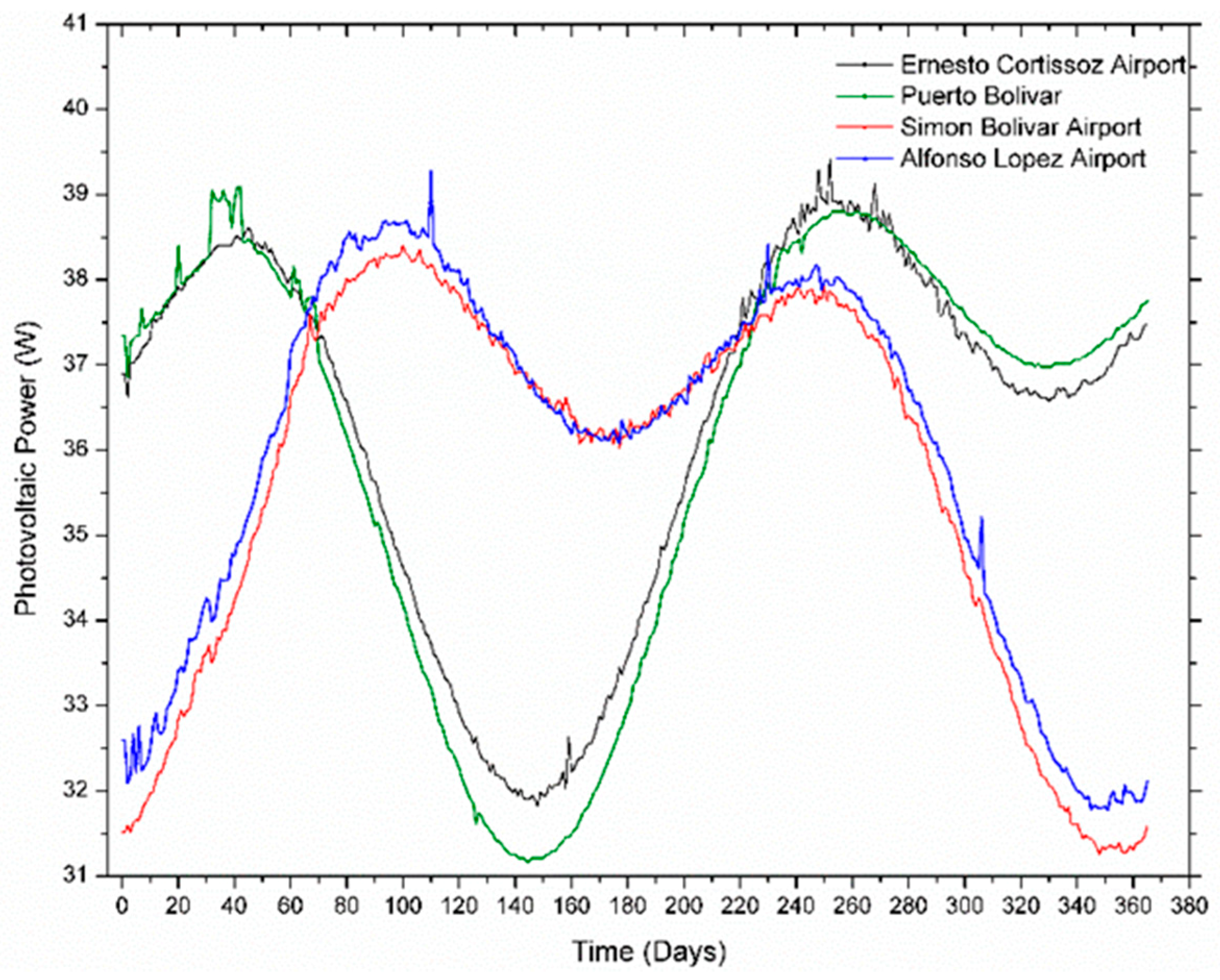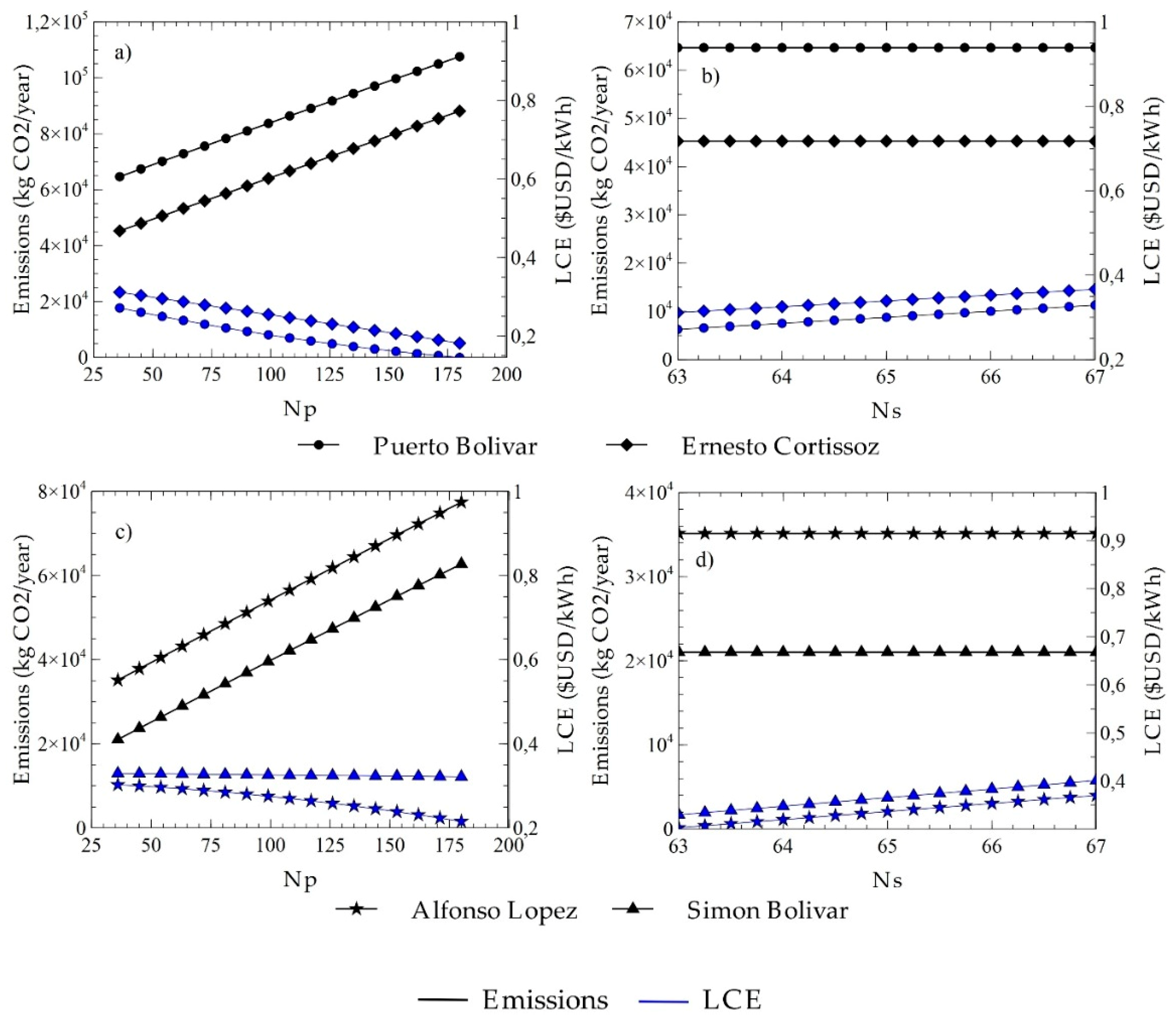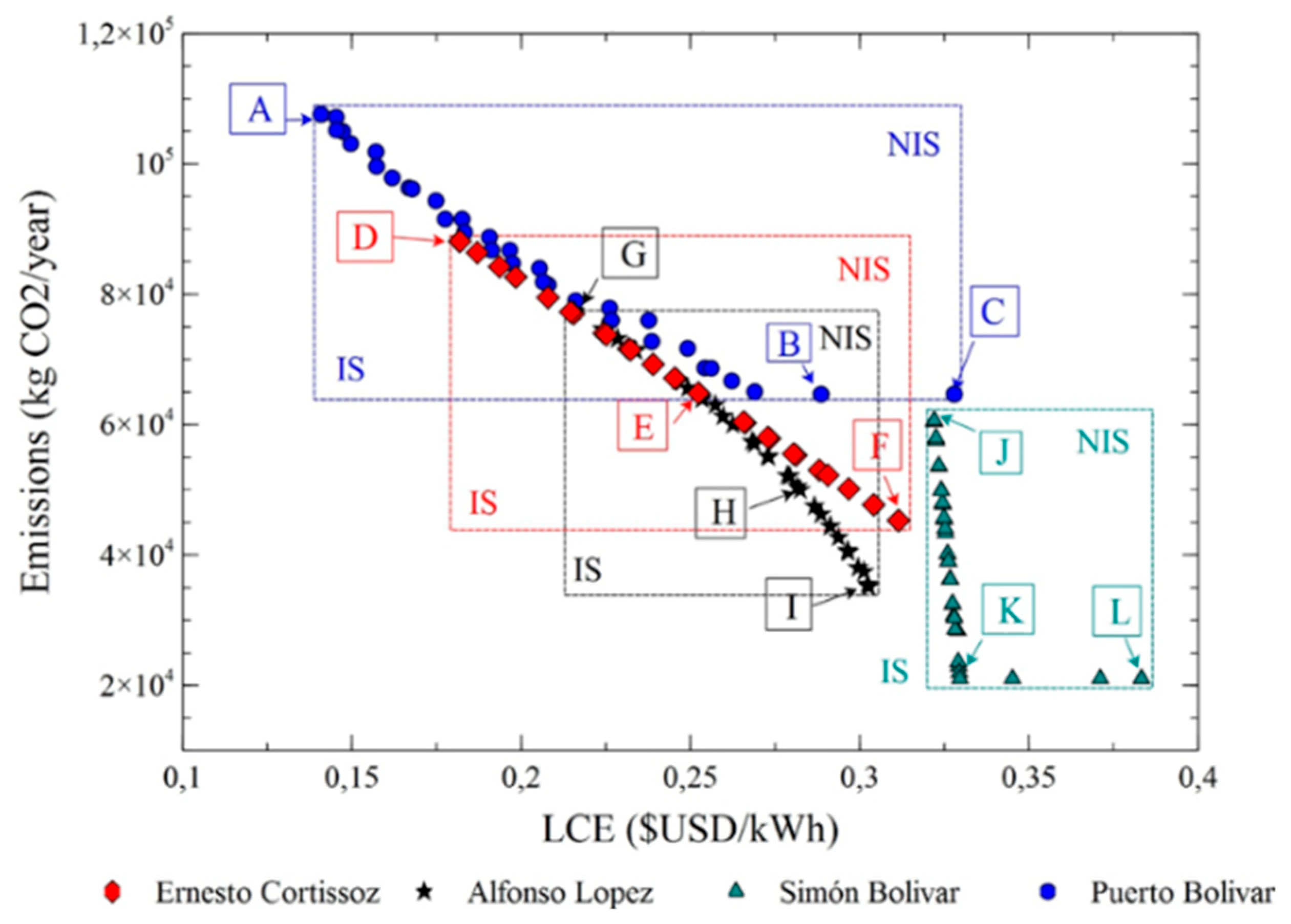Economic and Environmental Multiobjective Optimization of a Wind–Solar–Fuel Cell Hybrid Energy System in the Colombian Caribbean Region
Abstract
:1. Introduction
2. Methodology
2.1. Description of the Region and Information
2.2. System Description
2.3. Mathematical Fuel Cell Model
2.4. Mathematical Model of the Photovoltaic Solar Panel
2.5. Mathematical Model of the Wind Power
3. Results
3.1. Results of Dynamic Behavior
3.2. Multiobjective Optimization
4. Conclusions
Author Contributions
Funding
Acknowledgments
Conflicts of Interest
Abbreviations
| The following abbreviations are used in this manuscript: | |
| COM | Operating and maintenance cost |
| Levelized cost energy | |
| PEM | Proton exchange membrane |
| PH | Photogenerated |
| PID | Proportional, integral, and derivative |
| SHGEE | Hybrid electric power generation system |
| Nomenclature | |
| Ar | Flow area |
| C | Capacitance |
| Oxygen concentration at the liquid-gas interface | |
| E | Energy |
| Ego | Band space for silicone |
| F | Faraday Constant |
| h | Height |
| IFC | Electric current of the PEM cell |
| Bank interest rate | |
| K | Boltzmann constant |
| Ki | Temperature coefficient of the short-circuit current |
| M | Molar flow |
| N | Number of components connected in the system |
| P | Pressure |
| q | Electron Charge |
| R | Universal gas constant |
| RE | Resistance |
| Rt | Thermal resistance |
| T | Operating temperature |
| U | Fuel speed |
| Wind speed | |
| Vol | Volume |
| V | Voltage |
| Subscript | |
| 0 | Reference state |
| A | Anode |
| ACT | Activation |
| E | Electrolyze |
| INT | Internal |
| PV | Photovoltaic |
| S | Serial |
| SCR | Short-circuit |
| T | Thermal |
| TOT | Total |
| Greek Symbol | |
| Molar density of gases | |
| emissions for the PV systems | |
| Overvoltage due to activation | |
| Serial electrolyzed number | |
| Faraday Efficiency | |
| Hydrogen molar flux produced | |
| Ohmic voltage | |
| λ | Lighting of photovoltaic modules |
| Roughness coefficient | |
References
- Sinha, A. Inequality of renewable energy generation across OECD countries: A note. Renew. Sustain. Energy Rev. 2017, 79, 9–14. [Google Scholar] [CrossRef]
- Kim, K.; Park, H.; Kim, H. Real options analysis for renewable energy investment decisions in developing countries. Renew. Sustain. Energy Rev. 2017, 75, 918–926. [Google Scholar] [CrossRef]
- Shukla, A.K.; Sudhakar, K.; Baredar, P. Renewable energy resources in South Asian countries: Challenges, policy and recommendations. Resour. Technol. 2017, 3, 342–346. [Google Scholar] [CrossRef]
- Ahmed, S.; Mahmood, A.; Hasan, A.; Sidhu, G.A.S.; Butt, M.F.U. A comparative review of China, India and Pakistan renewable energy sectors and sharing opportunities. Renew. Sustain. Energy Rev. 2016, 57, 216–225. [Google Scholar] [CrossRef]
- Romo-Fernández, L.M.; López-Pujalte, C.; Bote, V.P.G.; Moya-Anegón, F. Analysis of Europe’s scientific production on renewable energies. Renew. Energy 2011, 36, 2529–2537. [Google Scholar] [CrossRef]
- Fernández, L.M.R.; Bote, V.P.G.; Anegón, F.M. Análisis de la producción científica española en energías renovables, sostenibilidad y medio ambiente (Scopus, 2003–2009) en el contexto mundial. Investig. Bibl. Arch. Bibl. Inf. 2013, 27, 125–151. [Google Scholar] [CrossRef]
- Abbasi, S.A.; Abbasi, T. Abbasi. Impact of wind-energy generation on climate: A rising spectre. Renew. Sustain. Energy Rev. 2016, 59, 1591–1598. [Google Scholar] [CrossRef]
- Congreso de Colombia Ley N° 1715 del 13 de mayo de 2014. Available online: www.fedebiocombustibles.com/files/1715.pdf (accessed on 8 September 2018).
- Kannan, N.; Vakeesan, D. Solar energy for future world: A review. Renew. Sustain. Energy Rev. 2016, 62, 1092–1105. [Google Scholar] [CrossRef]
- Islam, M.R.; Mekhilef, S.; Saidur, R. Progress and recent trends of wind energy technology. Renew. Sustain. Energy Rev. 2013, 21, 456–468. [Google Scholar] [CrossRef]
- Procolombia Electric Power in Colombia. Power Generation—2015. Available online: http://www.energynet.co.uk/webfm_send/1839 (accessed on 9 January 2019).
- Budes, F.B.; Escorcia, Y.C.; Ochoa, G.V. Optimization of a Biomass, solar and fuel cell Hybrid energy systems for a specific energy load using Homer Pro software®. Int. J. ChemTech Res. 2018, 11, 335–340. [Google Scholar]
- Sikka, M.; Thornton, T.F.; Worl, R. Sustainable Biomass Energy and Indigenous Cultural Models of Well-being in an Alaska Forest Ecosystem. Ecol. Soc. 2013, 18, 531–543. [Google Scholar] [CrossRef]
- Vides-Prado, A.; Camargo, E.O.; Vides-Prado, C.; Orozco, I.H.; Chenlo, F.; Candelo, J.E.; Sarmiento, A.B. Techno-economic feasibility analysis of photovoltaic systems in remote areas for indigenous communities in the Colombian Guajira. Renew. Sustain. Energy Rev. 2018, 82, 4245–4255. [Google Scholar] [CrossRef]
- Mikati, M.; Santos, M.; Armenta, C. Modelado y Simulación de un Sistema Conjunto de Energía Solar y Eólica para Analizar su Dependencia de la Red Eléctrica. Rev. Iberoam. Autom. Inform. Ind. RIAI 2012, 9, 267–281. [Google Scholar] [CrossRef]
- Bordons, C.; García-Torres, F.; Valverde, L. Gestión Óptima de la Energía en Microrredes con Generación Renovable. Rev. Iberoam. Autom. Inform. Ind. RIAI 2015, 12, 117–132. [Google Scholar] [CrossRef]
- López, A.; Somolinos, J.A.; Núñez, L.R. Modelado Energético de Convertidores Primarios para el Aprovechamiento de las Energías Renovables Marinas. Rev. Iberoam. Autom. Inform. Ind. RIAI 2014, 11, 224–235. [Google Scholar] [CrossRef]
- Esmaeili, S.; Shafiee, M. Simulation of Dynamic Response of Small Wind-Photovoltaic-Fuel Cell Hybrid Energy System. Smart Grid Renew. Energy 2012, 3, 194–203. [Google Scholar] [CrossRef] [Green Version]
- Ochoa, G.V.; Blanco, C.; Martinez, C.; Ramos, E. Fuzzy Adaptive Control Applied to a Hybrid Electric-Power Generation System (HEPGS). Indian J. Sci. Technol 2017, 10, 1–9. [Google Scholar] [CrossRef] [Green Version]
- De Dias, C.L.; Branco, D.A.C.; Arouca, M.C.; Legey, L.F.L. Performance estimation of photovoltaic technologies in Brazil. Renew. Energy 2017, 114, 367–375. [Google Scholar] [CrossRef]
- Abbes, D.; Martinez, A.; Champenois, G. Life cycle cost, embodied energy and loss of power supply probability for the optimal design of hybrid power systems. Math. Comput. Simul. 2014, 98, 46–62. [Google Scholar] [CrossRef]
- Parida, B.; Iniyan, S.; Goic, R. A review of solar photovoltaic technologies. Renew. Sustain. Energy Rev. 2011, 15, 1625–1636. [Google Scholar] [CrossRef]
- Cancino-Solórzano, Y.; Xiberta-Bernat, J. Statistical analysis of wind power in the region of Veracruz (Mexico). Renew. Energy 2009, 34, 1628–1634. [Google Scholar] [CrossRef]
- Observatorio del Caribe Colombiano. Región Caribe Colombiana 2015. Available online: http://www.ocaribe.org/region-caribe (accessed on 7 January 2019).
- Pandiarajan, N.; Ramaprabha, R.; Muthu, R. Application of circuit model for photovoltaic energy conversion system. Int. J. Photoenergy 2012, 2012, 410401. [Google Scholar] [CrossRef]
- Şen, S.; Demirer, G.N. Anaerobic tratment of real textile wastewater with a fluidized bed reactor. Water Res. 2003, 37, 1868–1878. [Google Scholar] [CrossRef]
- Padilla, R.V.; Demirkaya, G.; Goswami, D.Y.; Stefanakos, E.; Rahman, M.M. Heat transfer analysis of parabolic trough solar receiver. Appl. Energy 2011, 88, 5097–5110. [Google Scholar] [CrossRef]
- Ochoa, G.V.; Chamorro, M.V.; Jiménez, J.P. Análisis Estadístico de la Velocidad y Dirección del Viento en la Región Caribe Colombiana con Énfasis en la Guajira; Universidad del Atlántico: Barranquilla, Colombia, 2016. [Google Scholar]
- Bilil, H.; Aniba, G.; Maaroufi, M. Multiobjective Optimization of Renewable Energy Penetration Rate in Power Systems. Energy Procedia 2014, 50, 368–375. [Google Scholar] [CrossRef] [Green Version]
- Kamjoo, A.; Maheri, A.; Dizqah, A.M.; Putrus, G.A. Multi-objective design under uncertainties of hybrid renewable energy system using NSGA-II and chance constrained programming. Int. J. Electr. Power Energy Syst. 2016, 74, 187–194. [Google Scholar] [CrossRef]
- Ighravwe, D. A CRITIC-TOPSIS framework for hybrid renewable energy systems evaluation under techno-economic requirements. J. Proj. Manag. 2019, 4, 109–126. [Google Scholar]
- Chen, S.J.; Hwang, C.L. Fuzzy Multiple Attribute Decision Making Methods. In Fuzzy Multiple Attribute Decision Making; Springer: Berlin/Heidelberg, Germany, 1992; Volume 375, pp. 289–486. [Google Scholar]












| Decision Variables | Symbol | Maximum Value | Minimum Value | Criteria |
|---|---|---|---|---|
| Number of panels | 36 | 180 | C1 | |
| Number of stacks | 63 | 67 | C2 |
| Parameters of Design | ||||||||||||
|---|---|---|---|---|---|---|---|---|---|---|---|---|
| LCE | Emissions | |||||||||||
| Units | - | - | mol | Mol | kW | kW | kW | kW | kWh | $USD | $USD/kWh | |
| Ref | 36 | 65 | 0.0273 | 0.0273 | 13.184 | 52.446 | 14.757 | 7.388 | 769.306 | 208.657 | 0.2988 | 64,671.64 |
| A | 180 | 63 | 0.0273 | 0.0273 | 64.324 | 52.446 | 7.275 | 51.045 | 1534.544 | 195.051 | 0.1408 | 107,584.42 |
| B | 36 | 64 | 0.0273 | 0.0273 | 13.184 | 52.446 | 14.757 | 7.388 | 769.306 | 208.657 | 0.2885 | 64,661.49 |
| C | 36 | 67 | 0.0273 | 0.0273 | 13.184 | 52.446 | 14.757 | 7.388 | 769.306 | 208.657 | 0.3279 | 64,661.47 |
| Ref | 36 | 65 | 0.0734 | 0.0459 | 13.246 | 32.964 | 29.730 | 2.941 | 691.348 | 208.657 | 0.3325 | 45,179.31 |
| D | 180 | 63 | 0.0273 | 0.0273 | 64.623 | 32.964 | 7.138 | 31.726 | 1195.909 | 195.051 | 0.1817 | 88,119.16 |
| E | 102 | 63 | 0.0273 | 0.0273 | 37.130 | 32.964 | 13.421 | 10.516 | 824.123 | 189.532 | 0.2525 | 64,738.88 |
| F | 36 | 63 | 0.1501 | 0.0922 | 13.246 | 32.964 | 29.730 | 2.941 | 691.348 | 184.014 | 0.3114 | 45,279.78 |
| Ref | 36 | 65 | 0.1322 | 0.079 | 13.138 | 23.016 | 39.340 | 2.495 | 683.536 | 208.657 | 0.2988 | 64,671.64 |
| G | 180 | 63 | 0.0273 | 0.0273 | 64.101 | 23.016 | 6.461 | 20.579 | 1000.519 | 195.051 | 0.2154 | 77,455.43 |
| H | 77 | 63 | 0.1091 | 0.1156 | 27.028 | 23.016 | 27.413 | 5.258 | 725.039 | 186.773 | 0.2866 | 47,475.15 |
| I | 36 | 63 | 0.1322 | 0.079 | 13.138 | 23.016 | 39.340 | 2.495 | 683.536 | 184.014 | 0.3026 | 35,141.09 |
| Ref | 36 | 65 | 0.2102 | 0.1219 | 13.027 | 9.018 | 50.954 | 0 | 639.789 | 208.657 | 0.3593 | 21,022.60 |
| J | 172 | 63 | 0.0273 | 0.0273 | 60.749 | 9.018 | 7.280 | 4.049 | 710.762 | 242.767 | 0.3220 | 60,629.99 |
| K | 39 | 63 | 0.2238 | 0.5678 | 14.102 | 9.018 | 49.878 | 0 | 639.789 | 184.014 | 0.3294 | 21,959.29 |
| L | 36 | 66 | 0.1809 | 0.6725 | 13.027 | 9.018 | 50.954 | 0 | 639.789 | 221.424 | 0.3832 | 21,026.78 |
| Cases Studies | Objective Functions Values | Criteria Values | ||
|---|---|---|---|---|
| LCE ($USD/kWh) | Emissions (kg CO2/year) | C1 | C2 | |
| Puerto Bolívar | 0.2885 | 64,661.49 | 36 | 64 |
| Ernesto Cortissoz | 0.2525 | 64,738.88 | 102 | 63 |
| Alfonso Lopez | 0.2866 | 47,475.15 | 77 | 63 |
| Simon Bolívar | 0.3294 | 21,959.29 | 39 | 63 |
© 2019 by the authors. Licensee MDPI, Basel, Switzerland. This article is an open access article distributed under the terms and conditions of the Creative Commons Attribution (CC BY) license (http://creativecommons.org/licenses/by/4.0/).
Share and Cite
Valencia, G.; Benavides, A.; Cárdenas, Y. Economic and Environmental Multiobjective Optimization of a Wind–Solar–Fuel Cell Hybrid Energy System in the Colombian Caribbean Region. Energies 2019, 12, 2119. https://doi.org/10.3390/en12112119
Valencia G, Benavides A, Cárdenas Y. Economic and Environmental Multiobjective Optimization of a Wind–Solar–Fuel Cell Hybrid Energy System in the Colombian Caribbean Region. Energies. 2019; 12(11):2119. https://doi.org/10.3390/en12112119
Chicago/Turabian StyleValencia, Guillermo, Aldair Benavides, and Yulineth Cárdenas. 2019. "Economic and Environmental Multiobjective Optimization of a Wind–Solar–Fuel Cell Hybrid Energy System in the Colombian Caribbean Region" Energies 12, no. 11: 2119. https://doi.org/10.3390/en12112119





